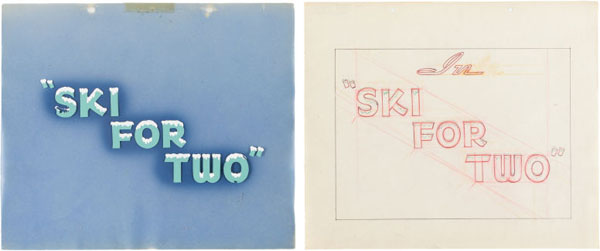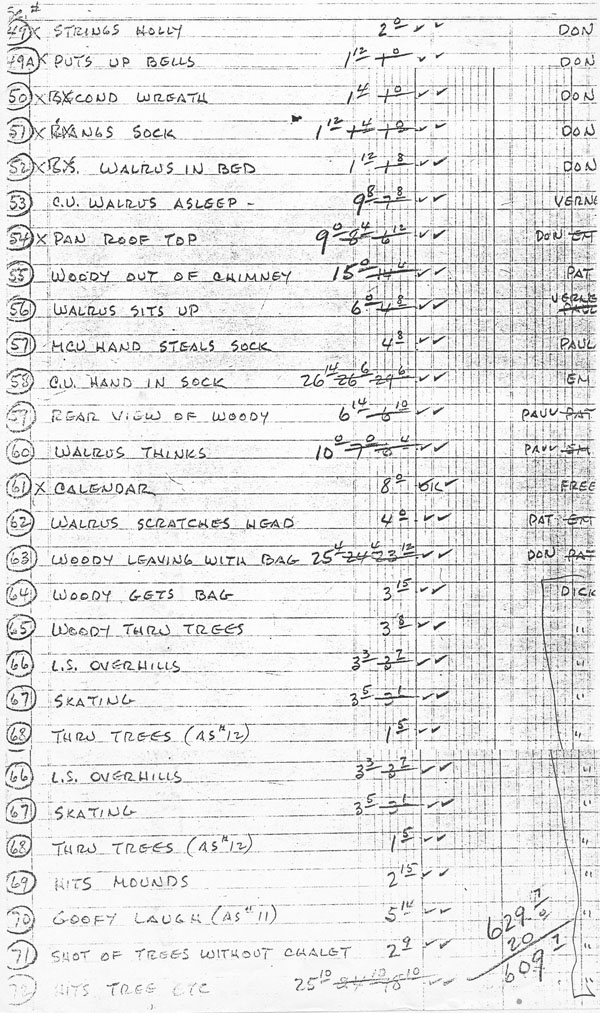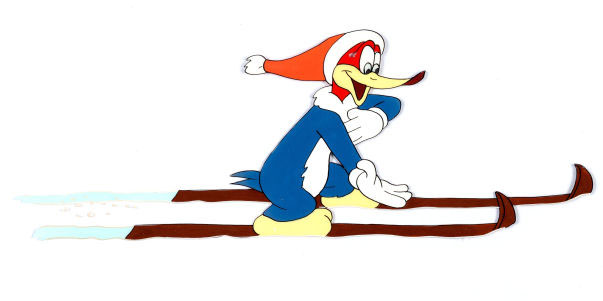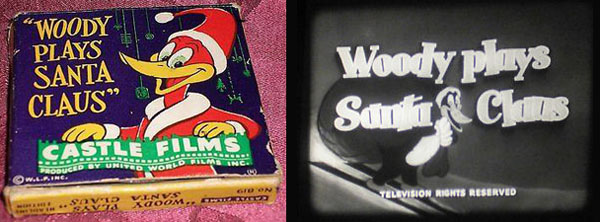
This week’s breakdown continues last month’s winter theme, with only a dash of Christmas, even though the holidays have come and gone.
 As Woody fixates on a brochure advertising the Swiss Chard Lodge, he is only interested in its refreshments, and states: “Oh boy, food! That’s my favorite dish!” Shamus Culhane’s third Woody Woodpecker entry transformed him into a glutton, a trait that dominated almost all of Culhane’s Woody cartoons. However, the Swiss Chard Lodge’s proprietor Wally Walrus’ appetite is just as insatiable. Culhane handles his introductory scene with the camera panning back-and-forth with Wally’s hands, at table level, as he reaches for his meal. Ambitious as the scene is, the complicated technical movement appears quite choppy on-screen. The point-of-view shots, in which different levels of foreground overlay are moved out in alternate directions as Woody descends down to the lodge, are handled more effectively. When Woody skis back with the large sack of food, the scene is reprised and amplified in the opposite direction, similar to Buster Keaton’s locomotive chases in The General.
As Woody fixates on a brochure advertising the Swiss Chard Lodge, he is only interested in its refreshments, and states: “Oh boy, food! That’s my favorite dish!” Shamus Culhane’s third Woody Woodpecker entry transformed him into a glutton, a trait that dominated almost all of Culhane’s Woody cartoons. However, the Swiss Chard Lodge’s proprietor Wally Walrus’ appetite is just as insatiable. Culhane handles his introductory scene with the camera panning back-and-forth with Wally’s hands, at table level, as he reaches for his meal. Ambitious as the scene is, the complicated technical movement appears quite choppy on-screen. The point-of-view shots, in which different levels of foreground overlay are moved out in alternate directions as Woody descends down to the lodge, are handled more effectively. When Woody skis back with the large sack of food, the scene is reprised and amplified in the opposite direction, similar to Buster Keaton’s locomotive chases in The General.
 Ski For Two displays experimentation in background styling. In most of the exterior winter scenes, the backgrounds have flat surfaces. Layout artist Art Heinemann and background artist Phil DeGuard – who later became a background artist for Chuck Jones at Warners used colored paper instead of paint for these sequences. The colored cut-outs use background depth convincingly; as Woody readies himself to take a shortcut to the lodge, he exits far into the horizon. In a later scene where Woody is being pulled by a disguised moose fastened with sleigh bells (animated by Don Williams), there are colored cut-outs of foreground and background elements.
Ski For Two displays experimentation in background styling. In most of the exterior winter scenes, the backgrounds have flat surfaces. Layout artist Art Heinemann and background artist Phil DeGuard – who later became a background artist for Chuck Jones at Warners used colored paper instead of paint for these sequences. The colored cut-outs use background depth convincingly; as Woody readies himself to take a shortcut to the lodge, he exits far into the horizon. In a later scene where Woody is being pulled by a disguised moose fastened with sleigh bells (animated by Don Williams), there are colored cut-outs of foreground and background elements.
As Woody skis down to the Swiss Chard Lodge, he sings the melody to The Sleigh (a la Russe), written in 1926 by Richard Kountz and Ivor Tchervanow. This song was believed to be in the public domain during Ski for Two’s production. Near the film’s completion, it was discovered that the tune was still under copyright. Since the sequence had already been animated to the music, and without the contingency of another song, producer Walter Lantz sent a fifty-dollar offer to the publishing firm of The Sleigh for its use in the film. The firm sent an indignant letter back, only accepting nothing less than a hundred dollars. Relieved of the costs, Lantz gladly paid them. Voice expert Keith Scott confirmed that Lee Sweetland, previously the singing voice for Woody in Barber of Seville, supplied his vocals again for the scene. In one of the surviving dialogue sheets, a noted inscription states “have Sweetland sing Woody’s laugh,” which he performs near the end. As a bonus, here’s the sequence, slowed-down:
Dick Lundy’s animation during the sequence is tightly synchronized to The Sleigh. It anticipates his directorial body at Lantz, where his characters’ actions were often accentuated with music. The scenes of Woody skiing down the hills, and up to the camera, are wonderful. Les Kline offers some unique timing solutions in this cartoon; Woody reaches into his pocket and displays his “reservations” for Wally in about four consecutive drawings. Later, in another scene with minimal drawings, Woody is pulled outside the lodge while eating, and then emerges back to finish his meal before being ejected again.
 Besides The Sleigh being utilized in the cartoon, the scenes of Wally’s excitement over “Kris Kringle” are delightful. Don Williams animates the fast-cutting sequence of Wally decorating the lodge with holiday trimmings. He later handles a moment of subtle characterization displaying Woody’s carelessness towards the moose ─ in scene 54, he crashes into the chimney and Woody bounces off his head in order to enter. Emery Hawkins is only credited for one shot in Ski for Two – scene 58, when Wally finds there are no presents in his stocking. Wally’s changes in expression are seamlessly fluid, from eager to beaming with joy, to disappointment, then determined and ultimately perplexed, as he looks out at the audience.
Besides The Sleigh being utilized in the cartoon, the scenes of Wally’s excitement over “Kris Kringle” are delightful. Don Williams animates the fast-cutting sequence of Wally decorating the lodge with holiday trimmings. He later handles a moment of subtle characterization displaying Woody’s carelessness towards the moose ─ in scene 54, he crashes into the chimney and Woody bounces off his head in order to enter. Emery Hawkins is only credited for one shot in Ski for Two – scene 58, when Wally finds there are no presents in his stocking. Wally’s changes in expression are seamlessly fluid, from eager to beaming with joy, to disappointment, then determined and ultimately perplexed, as he looks out at the audience.
The draft indicates the original title as “The Snow Bird.” The footage was approved on April 12, 1944 and was released about seven months later on November 13. The shot of Woody on the caboose was originally assigned to Hawkins, but the shot is just a (crudely-drawn) held cel of Woody and the moving train in the finished cartoon. Scene 55 is assigned to Pat Matthews, but is actually animated by Paul Smith. Matthews only animates one small shot of Wally in scene 62. (Several scenes are assigned to him, but replaced by other animators.)
Stay warm, folks! It might be a chilly one out there for some of you! Enjoy the breakdown video in the meantime…





(Thanks to Mark Kausler and Keith Scott for their help.)


 DEVON BAXTER is a film restoration artist, video editor, and animation researcher/writer currently residing in Pennsylvania. He also hosts a
DEVON BAXTER is a film restoration artist, video editor, and animation researcher/writer currently residing in Pennsylvania. He also hosts a 





















































































I like how the train stops. then shakes off the snow from head to tail like a dog.
Since the breakdown states “Woody hits reindeer”, that’s most likely what the character is, not a moose. Doesn’t even look like a moose.
http://www.patcartoons.blogspot.com/
They got Sweetland just in time. He was inducted into the Army in Sept. 1944.
When Wally hangs the decorations, the second time around the inked drawings are reused and painted on the other side.
Oh, thanks for solving the “Snow Bird” mystery. Variety reported on Dec. 8, 1943:
Walt Lantz has added two new subjects to his production sked at Universal. They are ‘Snow Bird,’ which will be a member of his ‘Woody Woodpecker’ series, and ‘Fish Fry’ for his ‘Andy Panda’ group. Lantz has signed Jack Teagarden, trombonist, for ‘Pied Piper.’
Variety, February 15, 1944:
Walt Lantz has set “Ski For Two” and “Screwball of Fire” as titles for next two Woody Woodpecker car-tunes for Universal.
And Variety, April 5, 1944:
Walter Lantz yesterday began scoring on three cartoons, “Beach Nut,” “Ski For Two” and “Slip Horn King of Polaroo.”
Thanks for the addendum, Yowp!
17 years before my birthday!
And we should add the voice of gagman Ben Hardaway as Woody and radio talent Jack Mather as Wally.
Love Calker’s “lummox” tempo of Jingle Bells to emphasize Wally’s denseness.
They really had no idea how to end cartoons at the Lantz studio, did they? 😉
At long last, the guy who drew the greatest Woody frame in existence. Thanks, Les!